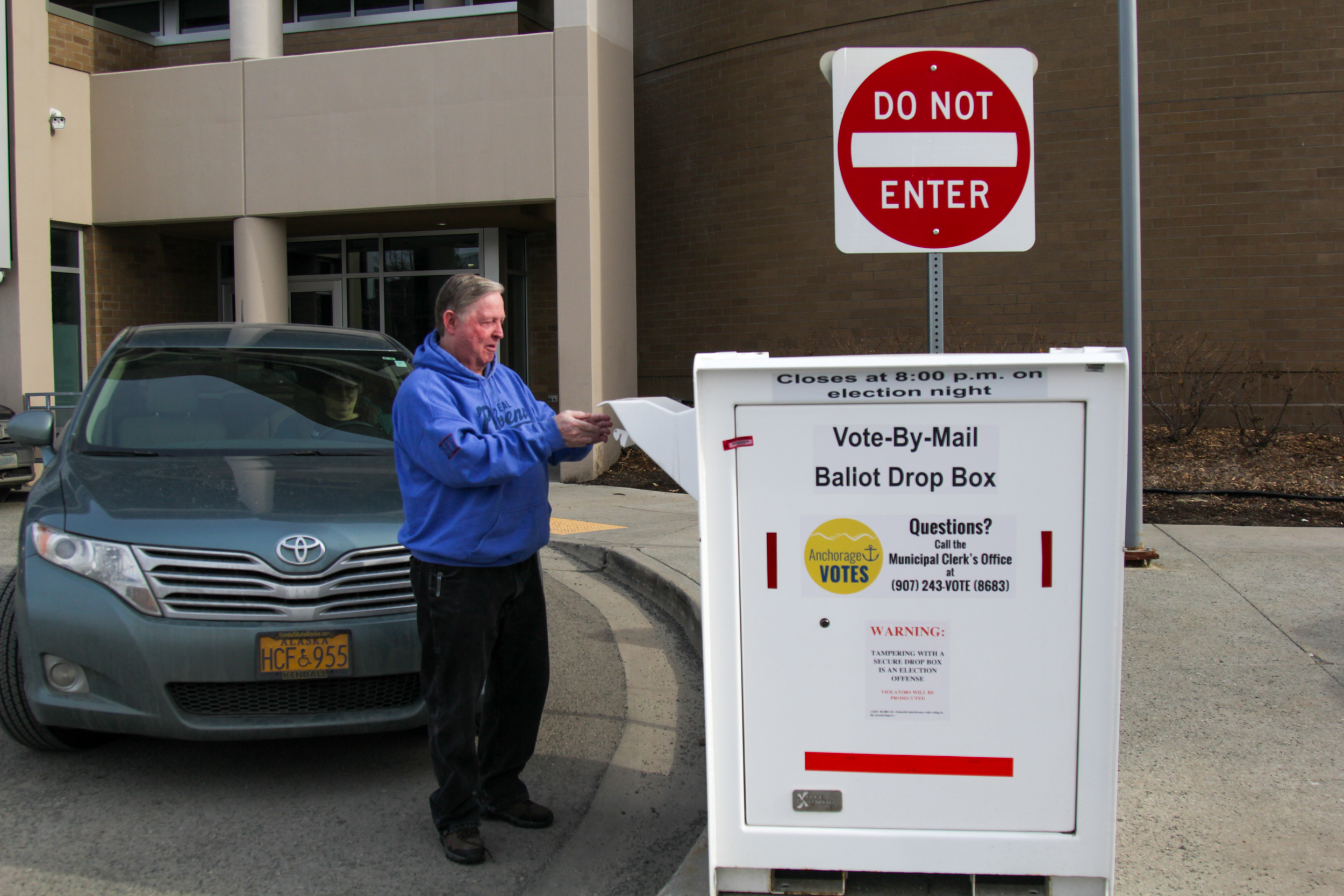
Tuesday, April 4, is the last day to vote in Anchorage’s by-mail municipal election.
The ballots are long this year, with questions on some filling up all four sides of two ballot cards. The mix of questions varies from area to area, and includes Anchorage Assembly and school board races, plus 15 ballot propositions.
Here’s more on what to know about the spring election.
How do I vote?
If you were registered to vote by March 5, your ballot package – which has materials barcoded specifically for you – should have arrived in the mail at the address tied to your voter registration with the state.
Fill out the ballot cards with black or blue ink. Remember to check both sides of the ballot cards. Put your filled ballot cards into the secrecy sleeve, and seal that inside the return envelope. You must use the ballot return envelope that came in the package.
On the outside of the envelope, read and sign the declaration – your ballot isn’t valid without this signature. A pair of election workers trained in signature verification will eventually check this signature against one on file with the state, so don’t be careless on this step.
Now your ballot envelope is ready to deliver.
How do I deliver my ballot envelope?
There are three ways:
- Mail it first class through the U.S. Postal Service. You’ll need to pay for postage. It must be postmarked on or before April 4 to count.
- Put it in one of the municipality’s 18 secure drop boxes by 8 p.m. on April 4. A map of locations is available here.
- Take it to one of three Anchorage Vote Centers, which will be staffed between March 27 and April 4. Hours and locations are listed here. These locations also have secure drop boxes.
What if I didn’t sign my ballot envelope or my signatures don’t match?
Election officials must send you a letter within a few days letting you know about the problem, and laying out ways to fix it. One way involves mailing back a form. The other is to meet with an election official in person.
Can I vote in person?
Sort of. There are no neighborhood polling places. However, you can still take your ballot package to one of the three Anchorage Vote Centers and fill it out in a booth there. These centers are located and City Hall, the Loussac Library and Eagle River Town Center. They’ll be staffed between March 27 and April 4. On Election Day, April 4, they’re open from 7 a.m. until 8 p.m.
The municipality switched from traditional, in-person elections to primarily vote-by-mail elections in 2018. The Anchorage Assembly made a series of policy decisions leading up to the switch beginning in 2015.
What if my ballot is damaged, I lose it or I never get one in the mail?
You can request a replacement ballot by calling the city’s voter hotline at 907-243-VOTE (8683).
Or, you can vote in person at one of the Anchorage Vote Centers. You’ll need identification, like a driver’s license, passport or even a hunting or fishing license.
Either way, the barcode that ties the original ballot to you will be invalidated. To dispose of the damaged ballot or if the lost ballot turns up, you should tear it up.
You can sign up for ballot tracking at AnchorageVotes.com to get an idea of where your ballot is.
Who am I voting on?
Voters are going to decide who will fill seven seats on the 12-member Anchorage Assembly, two seats on the seven-member Anchorage School Board and 31 seats on local service area boards.
For the seven Assembly races, there are 17 candidates competing. Voters only weigh in on the seats in their district.
For the two school board races, there are four candidates running. These races are nonpartisan and areawide, so everyone can weigh in on both.
There are also 15 ballot proposition questions.
What are the ballot propositions about?
Six of them are bond authorizations. These bonds are a form of long-term debt that the city can only incur with voter approval. These six questions are asking voters to let the city borrow up to $84 million, most of which would be spent on school and road infrastructure. There are also bond questions for parks, new gear for firefighters, and public safety and bus system improvements. If approved, the debts would be repaid over time with property taxes.
Five ballot propositions have to do with local service areas. These are jurisdictional carve-outs within Anchorage that geographically separate out whose property taxes pay for sometimes hyperlocal services and projects. One of these questions would create a new Chugach State Park Access Service Area covering the Anchorage Bowl. If that one goes through, then the idea is that those voters could be asked in the future to kick in some property taxes to improve access to the state park.
There’s one question to sweeten a residential property tax break.
And finally, there are three charter amendment questions. One would change who’s responsible for managing the city’s $400 million trust fund from the city treasurer to an appointed board. Another would make procedural and timing changes on how to fill vacancies on the Assembly or in the mayor’s office.
The very last question on the ballot would dedicate the city’s existing 5% marijuana sales tax to child care and early education. The tax raised $5.8 million in 2022.
When will we know the election results?
Election workers won’t begin counting votes until after voting closes at 8 p.m. on Election Night, April 4. Election officials plan to begin publishing partial, unofficial results on the city’s website around 8:30 p.m. that night.
Election Administrator Jamie Heinz said she expects to publish updates each evening that week. After that, the pace of updates will slow down as fewer valid ballots trickle in.
On a peak day, Heinz said election workers can process about 10,000 ballots. For context, about 70,000 ballots were cast in Anchorage’s last regular election.
The Anchorage Assembly must certify the results for them to become official. That vote is scheduled for the Assembly’s regular meeting on April 25.
Where can I learn more about the candidates and ballot propositions?
For the Anchorage Assembly and Anchorage School Board candidates, Alaska Public Media partnered with the Anchorage Daily News to build a candidate comparison tool. Check out candidates’ responses here. Readers and listeners helped inform the questions we asked.
Information about the ballot propositions is available here.
Independent information about candidates for boards of supervisors for various service areas is limited. For many of those openings, no candidates filed to run. Some of the candidates include campaign websites in their candidate filings.
Have a question about the city election that we missed? Email reporter Jeremy Hsieh at jhsieh@alaskapublic.org.
Jeremy Hsieh covers Anchorage with an emphasis on housing, homelessness, infrastructure and development. Reach him atjhsieh@alaskapublic.orgor 907-550-8428. Read more about Jeremyhere.





